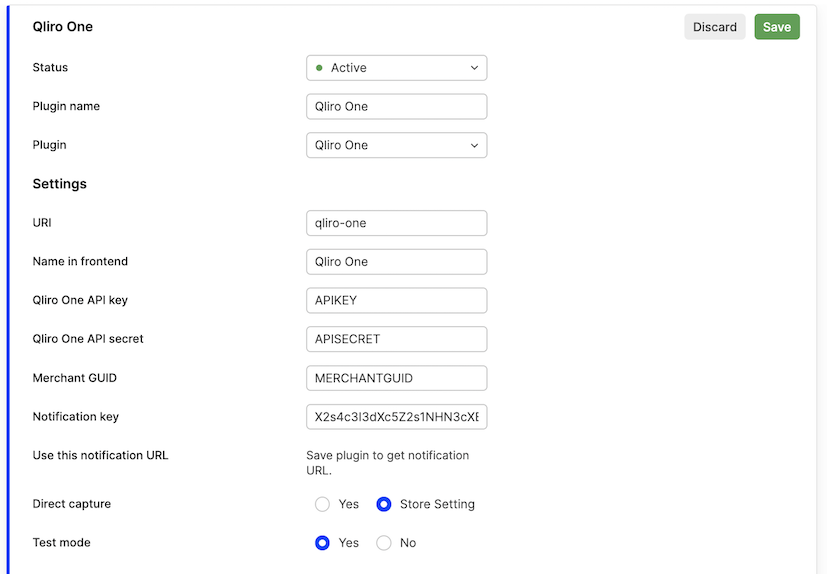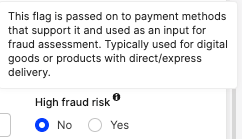Qliro One
Last updatedQliro One is a popular payment provider which allows payments with credit and debit cards, as well as "Buy now, pay after receiving goods" type of purchase. Here's all the information that you'll need to start using this plugin.
Gather information from Qliro One#
You need the following data:
- The API key for your Qliro store.
- The Secret for your Qliro store.
- Both
Merchant integrity policy-URLandTerms & Conditions-URLare required and need to be valid URLs - Merchant GUID for your Qliro store - if you want to see links to Qliro Merchant panel.
Create the plugin in Centra#
Add Qliro One to your store you want to use it for. Insert the data gathered above and place it in the following fields:

Testing
To use plugin in Test mode and test against Qliro API sandbox set the following setting to "Yes":

You will need to disable test-mode for the plugin in Centra when you run it in production.
Setup options#
Notifications
Notification endpoints for all kinds of incoming notifications: customer checkout status, order management status and order validation are defined dynamically and provided for Qliro by the integration plugin. There is no need to explicitly define them in plugin settings.
Payment flow
When customer makes a successful payment and is redirected to payment success page POST /payment-result is sent from frontend to Centra. The order will be placed and visible in AMS with Waiting for Payment flag and HOLD status. It will stay this way until the CustomerCheckoutStatus notification arrives with status="Completed" which means that the payment has succeeded and we now have confirmation from Qliro.
For debit/credit card payments Waiting for Payment flag and HOLD status are usually cleared within minutes after order placement.
For other types of payments that allow the customer to pay later in the process e.g. INVOICE the notification with status="Completed" might take longer time to be sent which will keep Waiting for Payment flag for longer time.
Require success validation
Optional order validation step fired when customer submits the order in the payment widget.
It validates following data:
- Customer identity (if option
Verify identity with BankID (SE only)is used) - Juridical type - whether the selected type is allowed by configuration
- Items availability
The result can be handled on frontend side, implementing callback onPaymentDeclined() which accepts decline reason as an argument. For more details please refer to Qliro documentation.
Allow organizations to place orders
By enabling "Company" you can allow businesses to also place orders using Qliro One:

Ask for newsletter signup
By enabling "newsletter signup" checkbox, it will be visible inside Qliro One widget. You can choose if it should be pre-checked or no.

Age restiction
Age restriction setting allows to decide whether you want to provide minimalCustomerAge parameter on payment session initialization. Setting the value "Yes" enables an additional attribute on product level of type "Age limit" - visible in Catalog/Attributes setup.
If there is a product with age limit restriction in the basket, the minimumCustomerAge value will be sent to Qliro.

High fraud risk flag "HasRisk"
Limits the list of available payment methods in Qliro checkout. Typically used for products that could potentially be targeted for fraudulent purchases. In Centra it's a boolean value configurable on product level. The parameter is passed to Qliro in the checkout when product marked as risky is added to cart. When risky product is removed from cart then all available payment methods will be shown.
"HasRisk" feature can be enabled in Qliro payment plugin settings:

When "HasRisk" feature is enabled in Qliro payment plugin settings - a custom attribute appears on product configuration page and allows a product to be marked as risky:

Verify identity with BankID - Sweden Only
Set to "Yes" if you want BankID to be required for customer to be able to complete purchase.
Customer information
The payment widget can be prefilled with customer data coming from the selected source:
- basket shipping address
- basket billing address
- customer address
You can select if you want the address filled by customer in the payment widget to be used as the one visible on the order.
Setting Use customer addresses from QliroOne to "No" will ignore the address coming from the payment widget, so it should be used only when customer address information is collected in a separate form before proceeding to payment.
Configuration allows for preventing customers from changing the data that the payment widget is filled with on checkout initialization using "lock" settings. Customer information can be locked partially or fully.
Geo-restrictions
As with all payment plugins if you want to pricelist/market/country restrict the plugin you have the ability to select this in the bottom of the setup.
Customization of Qliro One widget
You are able to customize colors in Qliro One widget - you are able to set colors of
- Background color
- Primary color
- Call To Action button
- Call To Action hovered button
You are able to configure corner radius of
- General corner radius
- Button corner radius

API
When properly configured Qliro will be returned both in Checkout API and Shop API as available payment method:
1
2
3
4
5
6
7
8
9
{
"paymentMethod": "qliroone-payment",
"name": "Qliro One",
"paymentMethodType": "qliro",
"supportsInitiateOnly": false,
"providesCustomerAddressAfterPayment": true,
"handlingCost": "0.00 SEK",
"handlingCostAsNumber": 0
}
When Qliro is selected as payment method on the selection, then a POST /selection/payment is called and payment session is initialized.
If the request fails, the details can be found in DIAGNOSTICS/DEBUG LOG.
If payment session initialization was successful, the following response will be returned:
1
2
3
4
5
6
{
"token": "89d3744441706b51d9bc4ba157607203",
"action": "form",
"formType": "qliro",
"formHtml": "<script type=\"text/javascript\">(function(w, g) { w[g] = {\r\ncheckoutWebAppBaseUrl: (...)"
}
The formHtml field should be used to render payment widget on frontend.
The customer will after finalizing be redirected back to the paymentReturnPage provided in the POST /payment-call.
The paymentReturnPage should then make a call with empty body to POST /payment-result - Centra backend will fetch the information about payment result from Qliro and respond with success or failure.
The result will also arrive to Centra backend with the push notification from Qliro.
Updates to active sessions
CheckoutScript
Qliro API allows for updates of the cart items during active payment session.
When the cart total is updated during active payment session, centraCheckoutSript should be used to suspend and resume the payment widget while Centra backend is sending updates towards Qliro API.
In order to resume, you will need to pass the newly updated basket total price to Qliro. You need to define var totalPrice in your checkout page, and when Qliro widget is active, you must update it with the current value of your selection.totals.grandTotalPriceAsNumber. For example, when adding POST /items/XXX or changing basket lines quantity using POST /lines/id, Centra returns the updated selection response, which contains the updated grandTotalPriceAsNumber. Alternatively, you can always fetch the current basket using GET /selection.
Once you have defined and set the value of var totalPrice, make sure it's visible in the scope of the script, and it will pick it up automatically when calling resume()
1
2
3
4
5
6
q1.onOrderUpdated(function (order) {
if (order.totalPrice === totalPrice) {
q1.unlock()
}
// else, don't do anything
})
More information about centraCheckoutScript can be found here
Replacing payment widget
Replacing widget on frontend could be required when updates to payment session are not allowed or result in error. Centra will try to create new payment session in Qliro and
will respond with paymentHTML field that contains the reloaded widget and qliroReplaceSnippet field indicating whether returned snippet should replace the existing one on the page.
1
2
"paymentHTML": "<script type="text/javascript">(function(w, g) { w[g] = {rncheckoutWebAppBaseUrl: "https://pago.qit.nu/checkout/webapp/",rncheckoutWebAppVersion: "1.74.0",rncheckoutWebApiBaseUrl: "https://pago.qit.nu/checkout/webapi/",rnqliroTermsUrl: "https://assets.qliro.com/terms/se/sv/terms/1/user_terms.pdf",rnorderId: "2830123",rncountry: "SE",rnlanguage: (..........)",
"qliroReplaceSnippet": true,
Whenever the call updating the selection state in Centra is made the response should be checked for qliroReplaceSnippet field, for example: voucher application, manipulating quantity of
checkout cart item, updating customer's shipping address and so on.
Frontend event listeners
After payment processing is initiated, updates to an active session in Qliro are not allowed.
To prevent modifying order in Centra after payment is initiated, frontend should make use of
onPaymentProcess() and lock the interaction with the checkout cart.
https://developers.qliro.com/docs/frontend-features/listeners
This needs to be done to prevent mismatch between Centra and Qliro by allowing updates in the checkout when payment was already initiated with a particular cart total.